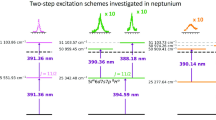Abstract:
A reduced dimensionality model is used to study the reaction OO O 3 ( X1A1 ) + O( 3 P ) by means of time-dependent and time-independent quantum-mechanical methods. State-selected probabilities and rate constants are obtained for the reactive process as well as for the inelastic collision in which the vibrationally excited oxygen loses one or more quanta. It is found that the experimentally observed jump in depletion rates above a critical value of v could be partially explained by the vibrational relaxation rather than reaction. Reaction only becomes important for relatively high translational energies and therefore the calculated rates are too small at the temperatures of interest. It is concluded, however, that the reaction saddle point region in the potential energy surface plays a crucial role in the enhancement of vibrational relaxation.
Similar content being viewed by others
Author information
Authors and Affiliations
Additional information
Received: 3 February 1998 / Revised: 27 March 1998 / Accepted: 15 May 1998
Rights and permissions
About this article
Cite this article
Campos-Martínez, J., Carmona-Novillo, E., Echave, J. et al. Reaction and inelastic processes in the collision O () + O (). Eur. Phys. J. D 4, 159–168 (1998). https://doi.org/10.1007/s100530050196
Issue Date:
DOI: https://doi.org/10.1007/s100530050196




